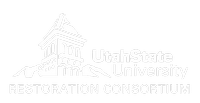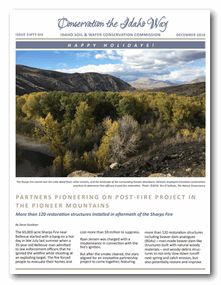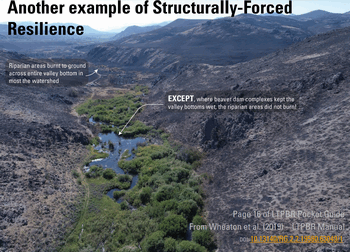 The idea that beaver dams can improve the resiliency of riverscapes to fire is common sense. That argument is made in Module 1’s Principles Lecture (e.g. Slide 18 at right). This page highlights some of the examples, anecdotes, and the surprisingly small amount (but convincing) of published scientific evidence that give credence to this idea that “It’s really not complicated: water doesn’t burn…”.
The idea that beaver dams can improve the resiliency of riverscapes to fire is common sense. That argument is made in Module 1’s Principles Lecture (e.g. Slide 18 at right). This page highlights some of the examples, anecdotes, and the surprisingly small amount (but convincing) of published scientific evidence that give credence to this idea that “It’s really not complicated: water doesn’t burn…”.
This page highlights some of the resources on:
- Meida coverage of resilience to fire
- Presentations on resilience to fire (mainly with beaver)
- Documenation of fire resiliency
- LTPBR funding opportunties for post-fire work
- General Public Fire Resources
If you are looking for examples of post-fire LTPBR case studies, see here:
Media Coverage
In recent years, there has been some media attention focused on the role that beaver can play in improving the resiliency of riverscapes to fire. This is perhaps best summed up in Emily Fairfax’s stop-motion story:
TV
PBS Special
Want to Solve Wildfires and Drought? Leave it to BEAVERS! - November 2021
News Articles
- Maughan R. 2013. Beaver restoration would reduce wildfires. The Wildlife News.
-
Stuebner S. 2018. Idaho Soil & Water Conservation Commission - “Partners Pioneering on Post-Fire Project in the the Pioneer Mountains” Conservation the Idaho Way. Idaho Soil & Water Conservation Commission.
- Randall, B. 2018. Beavers, Water, and Fire—A New Formula for Success Low-tech stream restoration works wonders for people and wildlife. National Wildlife Federation Blog.
- Goldfarb, B. 2020. How beavers became North America’s best firefighter. National Geographic.
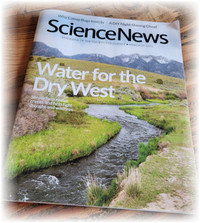
- Briana Randall. 2021. Simple hand-built structures can help streams survive wildfires and drought. Science News.
Ben Goldfarb’s (2020) article in NatGeo has gotten a lot of attention:
Beaver dams slow the spread of wildfires, and in some cases, can even extinguish them https://t.co/yAxhJxeEqG
— National Geographic (@NatGeo) September 25, 2020

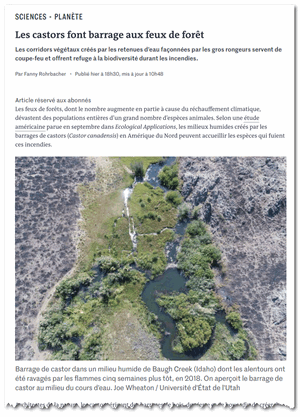 If you read French, LeMonde’s Fanny Rochrbacher picked up the NatGeo story and featured the Baugh Creek example extensively in this article:
If you read French, LeMonde’s Fanny Rochrbacher picked up the NatGeo story and featured the Baugh Creek example extensively in this article:
- Rohrbacher, F. 2020 Les castors font barrage aux feux de forêt. Le Monde. France. PDF
Radio
NPR All Things Considered
To improve wildfire resistance, researchers look to beavers appeared on All Things Considered on October 16, 2021 - 3 minutes
I’m beyond happy that my research on #beavers and #wildfires was shared all across the country this evening on @NPR All Things Considered @npratc!
— Dr. Emily Fairfax (@EmilyFairfax) October 16, 2021
Thanks @awhager for excellent reporting & @fluvialwheaton for explaining healthy riverscapes so clearly!https://t.co/IfySUqW7ur
NPR Science Friday
On October 22, 2021, Science Firday picked up Alex Hager’s story and did a piece on Beavers Build Ecosystems of Resilience’ - 17 minutes
🦫 Beavers are nature’s engineers and it turns out their habitats are wildfire-resistant.
— Science Friday (@scifri) October 22, 2021
On #SciFriLive📻, ecohydrologist @EmilyFairfax & @KUNC's @awhager share why people are turning to these talented rodents to help prepare for wildfires.https://t.co/QrmxIj4On4
Documentaries
In Sara Tensegrity’s award-winning 2018 documentary Beaver Believers, the Methow Beaver Project’s Kent Woodruff talks about how the beaver ponds helped stave off the impacts of the 2015 Twisp Fire. A trailer is below.
The Beaver Believers Kickstarter Trailer from Tensegrity Productions on Vimeo.
Presentations on Beaver & Fire
Below are some talks on beaver and fire. As more talks emerge, we’ll post them here (or let us know if you want to contribute one).
Emily Fairfax
In the recent California Beaver Summit, Emily Fairfax gave a wonderful talk on the resilence to fire and drought that beaver can bring to rivrescapes:
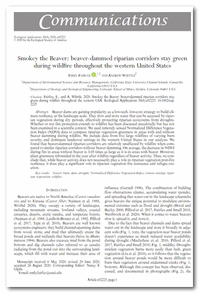 In a slightly longer webinar below, Emily Fairfax explains the concept and the science behind Smokey the Beaver.
In a slightly longer webinar below, Emily Fairfax explains the concept and the science behind Smokey the Beaver.
Joe Wheaton
Below, is an excerpt from LTPBR Workshop Module 1’s Principles Lecture on resilience:
- Invited Virtual Symposia Wheaton JM. 2021. Low-Tech Process-Based Restoration: Applications to Post Wildfire Landscapes. Natural Areas Association 2021 Symposia on “Nature’s Firefighters: The Role of Beavers in Wildfire Mitigation and Recovery..
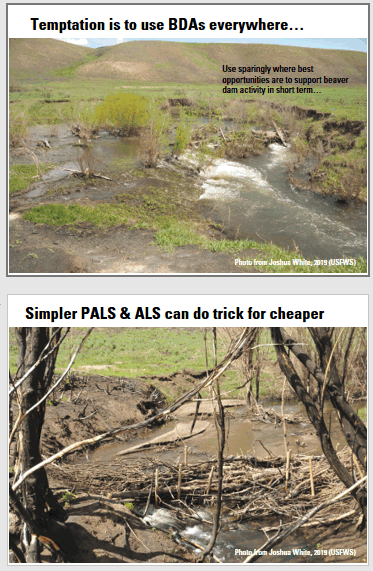 The slide show for the Utah Watershed Restoration Intiative covers some of the concepts and examples of LTPBR used in a post-fire context (see case studies also)
The slide show for the Utah Watershed Restoration Intiative covers some of the concepts and examples of LTPBR used in a post-fire context (see case studies also)
- Wheaton JM. 2019. Low-Tech Riverscape Restoration: Post Fire Use. UPCD-WRI Regional Partnership Workshop. Richfield, UT. DOI: 10.13140/RG.2.2.29413.96480
Documentation of Beaver Increasing Resilience
The documentation of beaver increasing resilience of riverscapes to fire exists in both popular literature and is starting to emerge in the scholarly literature.
Remember the #BootlegFire (3rd largest since 1900 in Oregon at > 413,000 acres)? Well here's a little taste of what #beaver-induced #ResilienceToFire looked like. Thank you Charlie Erdman from @TroutUnlimited. Not just anomalies. Got your own examples? Share! https://t.co/xiaWopyQXn pic.twitter.com/77I72Ir78p
— Joe Wheaton (@fluvialwheaton) October 18, 2021
Wikpedia
Rick Lanman updated Wikipedia to include in the North American Beaver page, a section on § Beaver ponds as wildlife refugia and firebreaks in wildfires.
Popular Literature
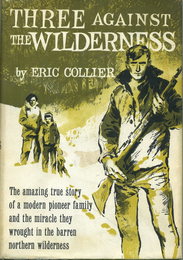 Three Against the Wilderness - If you really want to convince yourself we’re not on to anything new when it comes to partnering with beaver as a restoration tool, read Eric Collier’s Three Against the Wilderness. Although published in 1959, Eric describes his family’s efforts in the 1920s and 1930s to mimic the work of beaver in British Columbia by repairing the abandon dams left behind from their extirpation in his watershed in the 1830s and 1840s. It is one of the earliest examples we know of, of what you might call beaver dam analogues (though he didn’t give it a silly acronym). Eventually, he is able to stop doing the maintenance when a game warden brings him a few translocated, live beaver to introduce to the area.
Three Against the Wilderness - If you really want to convince yourself we’re not on to anything new when it comes to partnering with beaver as a restoration tool, read Eric Collier’s Three Against the Wilderness. Although published in 1959, Eric describes his family’s efforts in the 1920s and 1930s to mimic the work of beaver in British Columbia by repairing the abandon dams left behind from their extirpation in his watershed in the 1830s and 1840s. It is one of the earliest examples we know of, of what you might call beaver dam analogues (though he didn’t give it a silly acronym). Eventually, he is able to stop doing the maintenance when a game warden brings him a few translocated, live beaver to introduce to the area.
- Eric Collier (1959). Three Against the Wilderness. Victoria, British Columbia: TouchWood Editions. p. 362. ISBN 9781894898546.
Essays & Blogs
- Quinn-Davidson (2020) If Fire Were an Animal, it Would be Beaver, Landscape Treatments. A wonderful essay by respected fire expert Lenya Quinn-Davidson..
Scholarly Literature
Some of the scientific documentation we are aware of is listed below, as well as more conceptual summaries (let us know if you know of studies missing from here):
- Endter-Wada J, Kettenring KM, Sutton-Grier A. 2020. Protecting wetlands for people: Strategic policy action can help wetlands mitigate risks and enhance resilience. Environmental Science & Policy 108 : 37–44. DOI: 10.1016/j.envsci.2020.01.016
- Fairfax E. 2019. Building Climate Resiliency in a Warming World: from beaver dams to undergraduate education, Ph.D. Thesis, University of Colorado: Boulder, CO
- Fairfax E, Whittle A. 2020. Smokey the Beaver: beaver-dammed riparian corridors stay green during wildfire throughout the western USA. Ecological Applications n/a : e2225. DOI: 10.1002/eap.2225.
- Fesenmyer KA, Dauwalter DC, Evans C, Allai T. 2018. Livestock management, beaver, and climate influences on riparian vegetation in a semi-arid landscape. Plos One 13 : e0208928. DOI: 10.1371/journal.pone.0208928
- Hood GA, Bayley SE. 2003. Fire and beaver in the boreal forest-grassland transition of western Canada-A case study from Elk Island National Park, Canada. Lutra 46 : 235–242.
- Hood GA, Bayley SE. 2008. The effects of high ungulate densities on foraging choices by beaver (Castor canadensis) in the mixed-wood boreal forest. Canadian Journal of Zoology-Revue Canadienne De Zoologie 86 : 484–496. DOI: 10.1139/Z08-029
- Hood GA, Bayley SE, Olson W. 2007. Effects of prescribed fire on habitat of beaver (Castor canadensis) in Elk Island National Park, Canada. Forest Ecology and Management 239 : 200–209. DOI: 10.1016/J.Foreco.2006.12.005
- Wheaton, J.M., Bennett, S.N., Bouwes, N., Camp, R., Maestas, J.D. and Shahverdian, S.M. 2019. Chapter 2 – Principles of Low-Tech Process-Based Restoration. In: J.M. Wheaton, S.N. Bennett, N. Bouwes, J.D. Maestas and S.M. Shahverdian (Editors), Low-Tech Process-Based Restoration of Riverscapes: Design Manual. Utah State University Wheaton Restoration Consortium, Logan, Utah. 30 pp. DOI: 10.13140/RG.2.2.34270.69447
- Alexa S. Whipple (2019). Riparian resilience in the face of interacting disturbances: understanding complex interactions between wildfire, erosion, and beaver (Castor canadensis) in grazed dryland riparian systems of low order streams in north central Washington State, USA (Thesis). Eastern Washington University.
- Erin Stewart (2020). Beavers Buffering Blazes: The Potential Role of Castor canadensis in Mitigating Wildfire Impacts on Stream Ecosystems (Undergraduate Thesis). University of Puget Sound.
Potential Sources of Funding
There are numerous sources of funding for LTPBR, but to use as an emergency restoration tool post-fire, the following Federal programs (by agency) are good candidates:
- US Forest Service BAER (Burned Area Emergency Response) - Known example(s): Nevada Gance Fire - 2018 and South Sugarloaf Fire
- Bureau of Land Management BARR
- USDA Natural Resources Conservation Service EWPP (Emergency Watershed Protection Program)
Public Fire Information
- InciWeb - InciWeb is an interagency all-risk incident information management system.
- Managing Wildland Fires
- Fire Enterprise Geospatial Portal Fire Enterprise Geospatial Portal (EGP) is the authoritative source of standardized geospatial information for the full range of wildfire activities ranging from response to planning.
- National Interagency Fire Center
- Fire Weather and Avalanche Center

